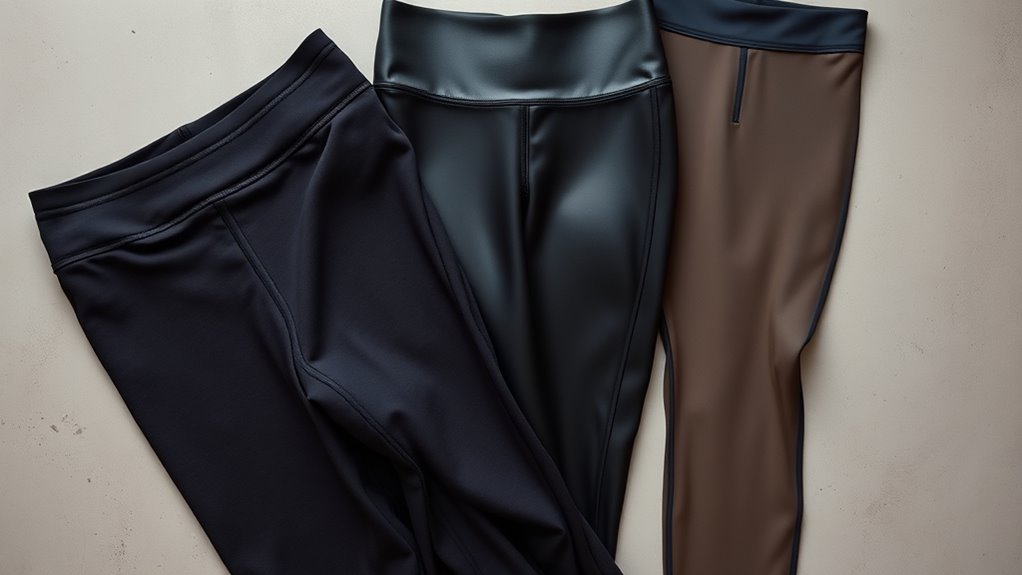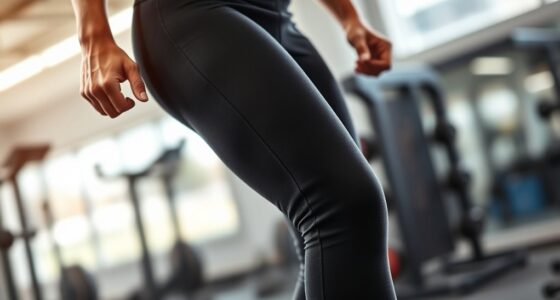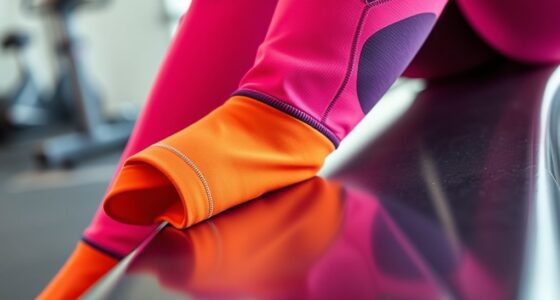Yoga pants, leggings, and tights differ mainly in fabric, fit, and purpose. Yoga pants are usually looser with a relaxed fit, made from durable fabrics like nylon and polyester, ideal for comfort and flexibility. Leggings are snug, high-waisted, and often made from stretchy materials like spandex, perfect for support and style. Tights are the most form-fitting, often sheer or opaque, suited for layering or specific activities. Continue exploring to discover how each option fits your needs.
Key Takeaways
- Yoga pants typically have a relaxed fit and moderate coverage, suitable for both athletic and casual wear.
- Leggings are form-fitting, high-waisted, and provide support for active movements and everyday styling.
- Tights are usually sheer or opaque, offering maximum coverage and often used for layering or specialized athletic activities.
- Fabric composition varies: yoga pants and leggings often blend nylon, polyester, and spandex for stretch and durability; tights may be lighter or sheer.
- Style, coverage, and intended activity determine the choice, with yoga pants favoring comfort, leggings supporting support, and tights emphasizing coverage.
Fabric Types and Material Composition

When choosing between yoga pants, leggings, and tights, understanding their fabric types and material compositions is essential because these factors directly affect comfort, durability, and performance. Fabrics like nylon, polyester, and spandex are common choices, each offering different benefits. Nylon and polyester provide excellent fabric durability, resisting wear and tear over time, while spandex offers exceptional material stretch, allowing for unrestricted movement. The blend of these fibers determines how well your clothing holds up and moves with you. High-quality materials ensure your yoga wear maintains its shape, resists pilling, and stays comfortable through repeated washes. Knowing the fabric composition helps you select pieces that support your activity level and last longer, making your workout wardrobe both practical and reliable. Additionally, understanding fabric blends can help you choose clothing that promotes breathability and moisture-wicking, enhancing your overall comfort during physical activity. A well-chosen fabric combination can also contribute to better temperature regulation, keeping you comfortable in various workout environments. Moreover, different fabric compositions can influence the overall fit and feel of your apparel, impacting your confidence and performance during exercise. Recognizing the specific performance benefits of these fabrics can further optimize your workout experience.
Fit, Design, and Purpose

The fit, design, and purpose of yoga pants, leggings, and tights are key factors that influence their suitability for different activities. Your choice impacts athletic performance, comfort, and style. Yoga pants typically have a relaxed fit for flexibility during stretches, while leggings are snug for support and mobility. Tights are often form-fitting and lightweight, ideal for precise movements or layering. Additionally, understanding the visual and auditory elements in marketing can help you make more informed choices and appreciate the fashion trends associated with these garments. Recognizing the seasonal variations in fabric and style can also enhance your comfort and enjoyment during outdoor activities or workouts.
Style, Coverage, and Use Cases

Each type of bottom—yoga pants, leggings, and tights—offers distinct styles, coverage levels, and ideal use cases that can influence your choice for workouts or casual wear. Yoga pants tend to have a relaxed fit with moderate coverage, making them perfect for both athletic activities and casual outings aligned with current fashion trends. Leggings are sleeker, often high-waisted, and provide more form-fitting coverage, suitable for gym sessions or stylish casual looks. Tights offer the highest coverage, often sheer or opaque, making them ideal for layering or specialized athletic use. Depending on your style preferences and activity, you’ll choose between athletic-focused options or casual, trend-inspired pieces. Your decision hinges on how much coverage you want and whether you prioritize function or fashion in your wardrobe. Additionally, understanding the different resources and tools available can help you select the best options for your needs, especially when considering clutter-free wardrobe management and storage solutions. Being aware of security features in athletic wear, such as hidden pockets or moisture-wicking fabrics, can also enhance your workout experience.
Frequently Asked Questions
How Do I Properly Care for and Wash These Garments?
When caring for your yoga pants, leggings, or tights, you should follow fabric care and washing tips to keep them in top shape. Always read the label for specific instructions, wash in cold water to prevent shrinking, and avoid fabric softeners which can damage elasticity. Turn garments inside out before washing, use gentle cycles, and air dry when possible. Proper care extends the life of your activewear and maintains its fit and appearance.
Are There Specific Brands Known for High-Quality Yoga Pants?
When choosing high-quality yoga pants, you should consider brand reputation and fabric innovation. Trusted brands like Lululemon, Athleta, and Alo Yoga are known for their durability and comfort, thanks to advanced fabrics that wick moisture and stretch well. These brands focus on quality, so your yoga pants last longer and perform better. Invest in reputable brands, and you’ll enjoy superior fit, comfort, and style every time you hit the mat.
Can Leggings Be Suitable for Formal or Professional Settings?
Is it possible for leggings to bridge the gap between comfort and professionalism? In a business casual or office-appropriate setting, you can make leggings work if you choose high-quality, sleek options and pair them with tailored tops or blazers. Think of your outfit as a canvas—leggings can be styled to look polished and appropriate, transforming casual wear into a smart, versatile look suitable for many professional environments.
What Are the Environmental Impacts of Different Fabric Materials?
When considering the environmental impacts of fabric materials, you should look for sustainable fabrics like organic cotton or recycled fibers, which reduce pollution and conserve resources. Eco-friendly production methods, such as low-water dyeing and renewable energy use, further lessen environmental harm. By choosing these materials, you help promote a more sustainable fashion industry, minimizing your carbon footprint and supporting eco-conscious brands committed to reducing their environmental impact.
How Do Temperature and Climate Affect Their Wearability?
Did you know that 80% of people find thermal comfort varies greatly with climate? When it’s hot, you might prefer lightweight tights for breathability, while in cold weather, thermal leggings offer better warmth. Temperature and climate impact seasonal adaptability, making certain fabrics more suitable for specific conditions. You’ll feel more comfortable and perform better when you choose clothing that matches the environment, ensuring ideal wearability year-round.
Conclusion
Now, picture yourself slipping into your favorite pair—maybe the sleek yoga pants, snug leggings, or cozy tights. Each offers a unique feel, fit, and look, ready to move with you through your day. Whether you’re stretching on the mat, running errands, or relaxing at home, choosing the right one elevates your comfort and style. So, pick the pair that matches your vibe, and let your confidence flow seamlessly with every step you take.









